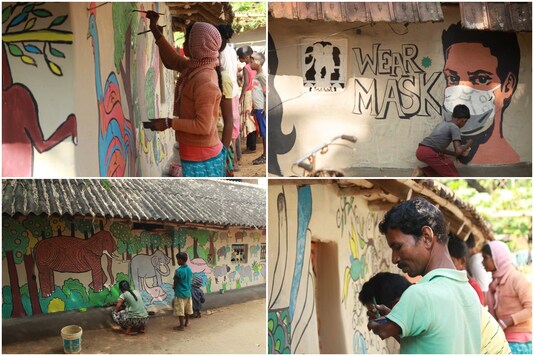It is often said that most beautiful places in the world are never found on the map. One such place is a hamlet called Lalbazar ensconced comfortably amid the forests of Jhargram, West Bengal.
Lalbazar recently grabbed news headlines for its beautiful mural-covered houses -- painted by the members of the local tribal inhabitants, the Lodha community -- and is at the precipice of turning into an important tourist location.
The village is so beautiful that it has been rechristened as khwaabgaon which means a village of dreams.
Lalbazar's dwellers - Lodhas - who are identified by the Central Government as a denotified tribe, and are similar to the Sabar tribe of West Bengal had historically been forest product collectors, farmers and daily wage workers. But, as their artistically painted houses draw many tourists to their village, they have turned to other creative endeavours like making katumkutum dolls, Katha art as well as eco-painting to earn a living.
In 2014, when Kolkata based artist, Mrinal Mandal wandered into Lalbazar, he recalls that it looked like any other tribal settlement, with thatched roofed mud houses. "There were about 80 inhabitants, who made little money from daily labour jobs, and farming. At the time, I was mesmerized by the natural beauty of the place. It was isolated and cosy, with a single road leading up to it, and nothing but forests surrounding it. I had thought that it would serve as a wonderful retreat or studio for urban artists," he said.
" However, the more I got to know the Lodhas I was fascinated by their intuitive understanding of creative processes -- like sculpting and painting -- and how they pass down such knowledge through the generations. Young kids learn so quickly here, by just watching their elders. They know so many things about art instinctively, which we have to go through the rigour of academics to imbibe. Therefore, I shifted my focus to empowering the Lodhas," pointed out the artist.
Mandal, who is the founder of Chalachitra Academy, a collective of like-minded artists, and intellectuals who work on documentation, preservation and promotion of dying art forms from rural, underprivileged communities, finally began working with the Lodhas in Lalbazar in 2018.
"The first step was to establish a workshop for the tribal kids in Lalbazar on different art forms like eco prints, vegetable dye, pattachitra, burnt earth pottery etc. They learned them diligently, and when we initially asked the permission to paint murals on the exterior of the houses in the area, the villagers readily agreed and gave us a helping hand," said Mandal. In the last three years, all the houses in the village have been painted with colourful wall art.
The walls of the mud houses are retouched every year, which means the paintings have to be done on a yearly basis too, and Mandal said that this year it was the villagers who did the majority of the painting.
" Our basic brief was that they should draw from their surroundings and experiences. And, we saw that they chose animals like the ducks, cattle and hens. Sometimes, elephants visit their village too, so they have drawn elephants as well. There is a tiny zoo nearby, therefore, whatever animals they see in the zoo, they paint. The wall art also depicts scenes of their festivals like Bandhna parab," said Mandal.
Only a four-hour drive from Kolkata, Lalbazar has already started attracting a large hoard of tourists. While that is good news for the villagers because it increases their chance to make a living off their art, it is a double-edged sword, pointed out Mandal.
"While the fact that creative objects are being sold from this village on a daily basis is a heartening development, tourists flocking at Lalbazar routinely is a source of both joy and concern. It worries me that if too many people crowd the village on a regular basis, it would completely disrupt the everyday lives of the lodhas," said Mandal.
“Also, people nowadays have little respect for the places they travel to. We have already put up a notice board that asks for donations to the locals, from those tourists who want to take pictures. It is, of course, voluntary, and there is no fixed amount. But it can help the locals, so the tourists should pay,” said the artist.
Mandal who has been working for 22 years with backward communities, and trying to preserve their art and history, told News18,” our aim is not to develop Khwaabgaon into a tourist space, because if that happens, no one will be able to do any work there. But we do want to empower the locals so that they can make a living from their art. Many inhabitants, irrespective of their age and gender, are already learning to make kantha, eco-painting and batik, and we are introducing them to the channels through which they can sell their works."
"We had also taught the villagers the art of mime by collaborating with Jogesh Mime Academy. We plan to construct an artist studio in Lalbazar so that artists from other villages and cities can also visit and live in Lalbazar, and learn the art,“ he added.

